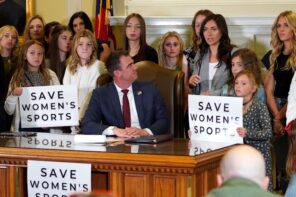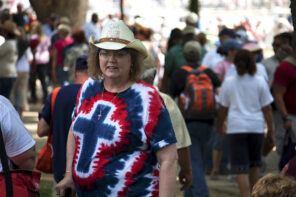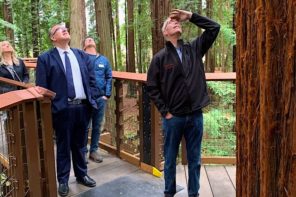You can read about them in a steady stream of reports heralding the demise of 21st-century American Christianity: the growing population of “Nones” who are no longer filling church pews. The label, of course, comes from that dangling multiple-choice item on questionnaires asking about religious affiliation: “None of the above.”
“The Nones” is an unfortunate term, easily confused with “the nuns.” You can’t use it in conversation without spelling it out. But Nones not nuns: vows are not their specialty.
Who are they? Although the unaffiliated are a varied bunch, sociologists reassure us that a great many of them self-identify as “spiritual.” The spiritual-but-not-religious subset of Nones haven’t given up on God (whoever or whatever they conceive God to be). Their search for the divine has simply broadened beyond traditional churches.
A great many Nones are the spiritual progeny of the cheerful, well-dressed parade of Eisenhower-era churchgoers: fathers in their Mad Men suits, mothers in their pert hats and white gloves. They are Dick, Jane and Sally from the elementary-school readers, now with children and grandchildren of their own. (“See Dick. See Dick run. See Dick run away from church.”)
Back then, the cultural mainstream proclaimed that God was firmly installed in the churches and all was right with the world. (Except for the Godless Communists. But we knew our hymns were the talisman that kept them at bay.)
“American Christianity—especially its Mainline Protestant variety—has largely forgotten how to seek out and visit the ad hoc places of prayer in our culture.”
Then the millennium turned, and the worm with it. The Y2K bug became the least of pastors’ worries. The steady stream of defections to the “None” column had become undeniable.
Pastors like me, who preach weekly and tend our graying flocks, are painfully aware of their absence. Even the big-box, nondenominational preachers at the edge of town—they of the hulking auditoriums and jumbo screens—are noticing the empty seats, once the clouds from their smoke machines disperse.
I’ve served my present congregation for 25 years. Just the other day, while soothing my tired muscles in the hot tub at the gym, I started talking to a woman who turned out to be a former parishioner. I didn’t recognize her, although I’d baptized her infant son, now in his twenties. She didn’t recognize my graybeard self at first, either—admittedly, I was out of uniform—but she said I looked familiar.
Turned out, she was a classic None: not upset at the church, particularly—just having drifted away, feeling vaguely guilty and rootless.
Surely, reports of the death of American Christianity are greatly exaggerated—but reaching and listening to Nones like her (not to mention their baptized but unchurched children), remains a puzzle that keeps parsonage lamps and computer screens burning late into the night.
Curiously, the New Testament offers a framework for understanding today’s Nones. Paul’s travelogue in the Acts of the Apostles contains this line, recounting his visit to Philippi: “On the Sabbath day we went outside the gate by the river, where we supposed there was a place of prayer; and we sat down and spoke to the women who had gathered there” (Acts 16:13).
A riverbank? Really? It’s a peculiar meeting place. Why not the synagogue? Was there no Philippian equivalent of Athens’ Temple to An Unknown God (Acts 17:23)? Why gather outdoors, outside the city walls, exposed to the elements? Likely it was because these spiritual seekers didn’t feel comfortable anywhere else.
“In each city he visited, the Apostle’s strategy was to seek out God-fearers wherever they happened to be. These half-committed, outside-looking-in seekers eventually formed the nucleus of the Christian church.”
Among that crowd was Lydia, a “seller of purple.” Lydia was an entrepreneur in the new economy of that day: a merchant whose niche was marketing the costly purple cloth that was all the rage at the imperial court. Strong, self-sufficient women like Lydia felt marginalized by the religious establishment. And so they sought out the riverside place of prayer.
Lydia was a “God-fearer,” in first-century parlance. She was a Greek with an interest in Judaism, who observed synagogue worship from the margins but couldn’t bring herself to commit. (As a woman, Lydia would have found conversion to Judaism easier than for her male colleagues; adult circumcision was a pretty high bar.)
The Book of Acts recounts Paul’s use of the God-fearer label a few chapters earlier: “Men of Israel and you who fear God, listen” (Acts 13:16). Clearly he’s aware there are two distinct constituencies within the range of his voice. Today we’d call them churchgoers and Nones.
But should we? “Nones” is a slippery, amorphous term, a null set. Maybe we’d do better to dust off the old God-fearer moniker, and apply it to those who are still coloring outside the religious lines as Lydia once did. American Christianity—especially its mainline Protestant variety—has largely forgotten how to seek out and visit the ad hoc places of prayer in our culture.
And where do we find these places of quiet spiritual striving? It takes creativity to imagine where they may be in our communities. One thing’s for sure: they don’t resemble churches.
A leading gathering-place for God-fearers—one that touches all our communities—isn’t a place at all, in the ordinary sense. It’s the internet: social media in particular. Twenty-first century God-fearers park themselves beside their swift-flowing Facebook and Twitter feeds as Lydia sat beside the river of old, eyes peeled for hints of the eternal.
Judging from the torrent of spiritual content that surges by, sparking comments, reposts and debate, social media can function as an unconventional place of prayer. You can be sure Paul, had he lived today, would have spent a good deal of time on that particular riverbank.
In each city he visited, the Apostle’s strategy was to seek out God-fearers wherever they happened to be. These half-committed, outside-looking-in seekers eventually formed the nucleus of the Christian church.
For we who lead traditional congregations, maybe this is our Philippi moment.





